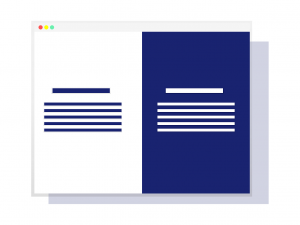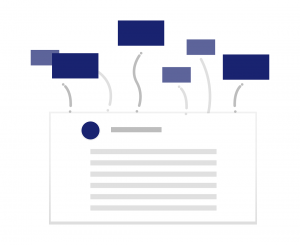I wrote a series of articles on the editing process for a publisher I’ve worked for, Crystal Publishing, and they were kind enough to let me re-post the articles here on my blog. Last time, we talked about the basics of the editing process. Today we’ll delve into my favorite type of editing: developmental editing. You can also read up on copyediting and proofreading.
Editing comes in different stages. Not all editors engage in all types of editing, so you should be aware of what type of help you are looking for when you begin to approach editors. The broadest level of editing is usually called content or developmental editing. As the terms are more or less interchangeable, I’ll just refer to it as developmental editing. In this type of editing, the editor helps you develop your content as a whole.
The editor will look at your manuscript from a big picture point of view and provide suggestions for overall improvement. This could be improvement to:

- style
- voice
- plot (or argument, for non-fiction)
- pacing and flow
- dialogue
- description
- character development
- syntax
- sentence structure
- and more
Essentially, the developmental editing will address anything the editor feels can make your work better and more accessible to your readers. Often this stage will include fixes to grammar and spelling as well, but the main focus is on the larger picture.
Every piece of writing should undergo some form of developmental editing, whether fiction or non-fiction.
When Do You Need Developmental Editing?
Typically, developmental editing evaluates a full draft of your manuscript. Developmental editing can be done on a first draft, but often it is better on a revised draft. I highly encourage writers to perform their own self-editing process on their first draft before submitting anything to an editor (and certainly before trying a publisher).
That being said, if you find yourself in need of editorial advice when you’re only 50% done with your manuscript, or even in the brainstorming stage, all is not lost. An editor or writing coach can give you the same type of content advice on unfinished works or even just story ideas, but typically this is called a manuscript evaluation or even just writing coaching. Many developmental editors will offer this service on an hourly basis.
The writing process is never really over. So don’t wait until your draft is 100% done before you look for an editor—because chances are, you’ll never feel you’re 100% done. I often tell writers to look for an editor when they feel they’re about 90% done. They’ve got all the essential plot points written out, or the argument fully articulated, but maybe not every last detail. You can always fill those in later—or your editor may say you don’t need them!
The Process
 Whether you’ve found your editor on your own or are working with a publisher, the process should be fairly similar. You will send your manuscript to the editor. While the editor has it, resist the urge to make changes! You don’t want to have multiple different versions of your story floating around; this will only lead to confusion and potential continuity errors. You can always take note of your ideas and add them in when you do your post-editor revisions. After your editor has finished their developmental edit, they will send the edited draft back for you to implement their suggestions. Often this will arrive in the form of a track-changed document. Your editor may also include a separate manuscript evaluation: several pages of their thoughts and opinions on the book overall.
Whether you’ve found your editor on your own or are working with a publisher, the process should be fairly similar. You will send your manuscript to the editor. While the editor has it, resist the urge to make changes! You don’t want to have multiple different versions of your story floating around; this will only lead to confusion and potential continuity errors. You can always take note of your ideas and add them in when you do your post-editor revisions. After your editor has finished their developmental edit, they will send the edited draft back for you to implement their suggestions. Often this will arrive in the form of a track-changed document. Your editor may also include a separate manuscript evaluation: several pages of their thoughts and opinions on the book overall.
As I mentioned in the previous article, no editor ever expects an author to accept every single one of their suggestions. Often, we hope that you as the author will see our suggestions and improve upon them even further. Our job is not to rewrite the manuscript for you; it is to help you rewrite the manuscript. However, do not be too quick to discount your experienced editor’s advice. Often an idea that makes perfect sense in your head can come across as confusing to a reader because they do not have all the background knowledge you do. Editors help bridge the gap between your knowledge and the reader’s. Listen to them.
Sometimes, a draft will need to go through multiple rounds of developmental editing. But once all the big issues have been dealt with, the draft is ready for copyediting or line editing. The topic of the next article in this series!
Why Developmental Editing?

I’d like to close with my thoughts on why developmental editing is important—something that isn’t in the newsletter because there just wasn’t enough space. Sometimes writers don’t want to take the time (or money) to have an editor do a developmental edit. They think they only need a simple line edit or even a proofread. And perhaps every once in a while that’s true. But I have yet to come across an unpublished, not-yet-edited manuscript that doesn’t need developmental editing.
Being a writer is amazing. You have entire worlds in your head. But no other person who reads your book is going to have that world in their head. Some things simply won’t make sense to them without the background knowledge you have. Or some of the things you find fascinating may come across as boring. Critique groups and beta readers can help you spot some of these problems. But editors are trained to find these problems and help you translate your vision. They will be able to provide practical solutions.
A proofreader will help you find typos and misplaced commas. But they won’t help you make the soul of your writing stronger. For that, you need a developmental editor.
Up next, delve into the differences between two more levels of editing, copyediting and proofreading.

